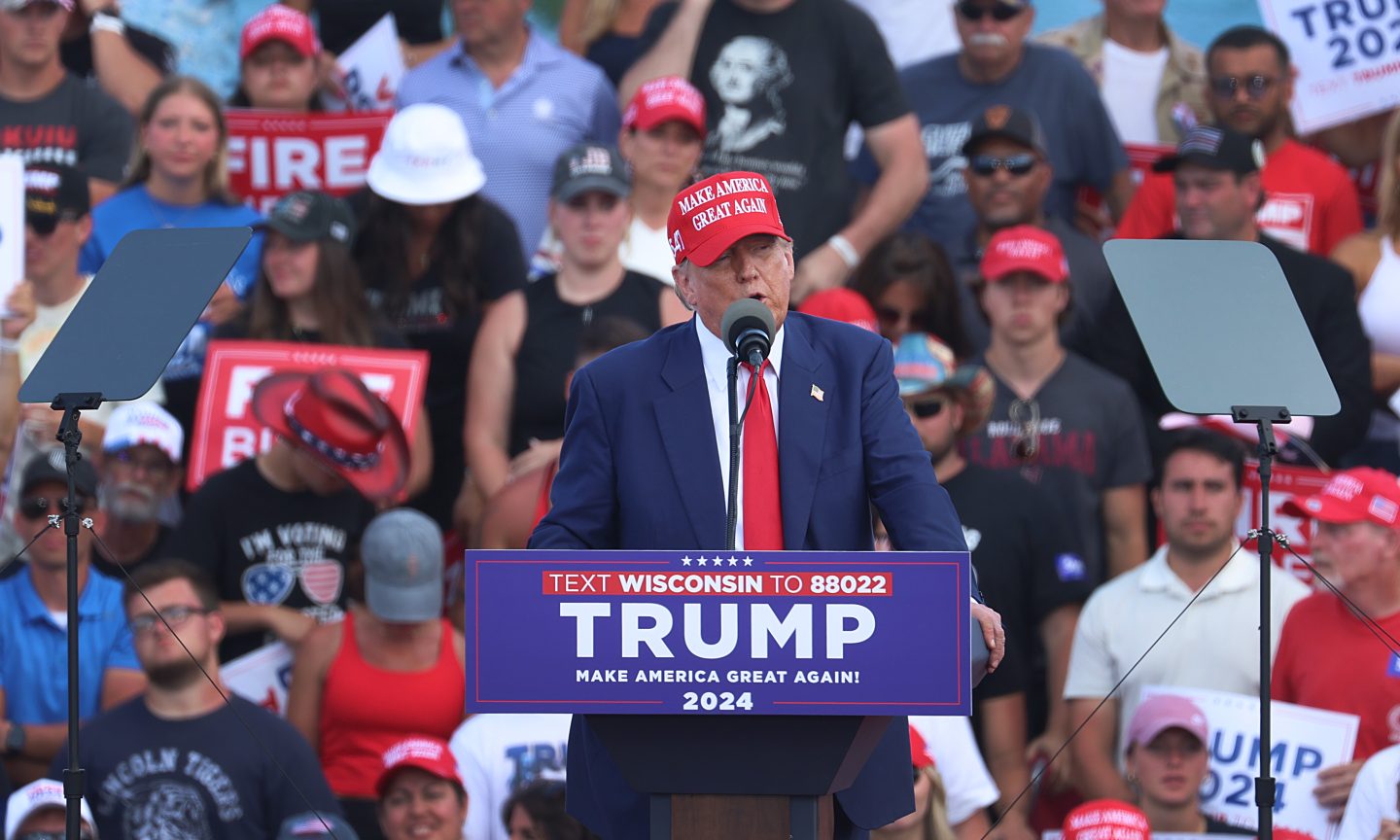At the first debate between President Joe Biden and former President Donald Trump on June 27, the candidates sparred as they each made their pitches to American voters. When not trading barbs or meandering into non sequiturs, the candidates managed to voice their views on major economic issues. Here’s a head-to-head rundown of what they had to say.
The economy, in general
Biden: When asked what he would say to voters who feel they are worse off under his presidency compared to Trump, Biden responded, “Take a look at what I was left with when I became president — what Mr. Trump left me. We had an economy that was in free fall.”
Biden touted job creation and his administration’s work to bring down prescription drug prices. He said there was more to be done and pointed specifically to lowering housing costs by building new housing and capping rents.
Trump: The former president claimed that he presided over “the greatest economy in the history of our country” and asserted that he “never got the credit for getting out of that covid mess.” He said the only jobs Biden created “are for illegal immigrants and bounce-back jobs that bounced back from covid.” He also blamed Biden for inflation saying, “inflation is killing our country — it is absolutely killing us.”
Throughout the debate, Trump turned many of his answers toward immigration and made frequent xenophobic remarks.
Tariffs
Trump: When asked how he would ensure that his proposal to impose a 10% tariff on all imported goods would not drive prices higher, Trump said, “Not going to drive them higher. It’s just going to cost countries that have been ripping us off for years, like China and many others.”
Tax cuts and national debt
CNN’s Jake Tapper noted that the Trump administration approved $8.4 trillion in new debt while Biden has so far approved $4.3 trillion in new debt. Trump has proposed extending tax cuts to businesses. Tapper asked Trump, “With the U.S. facing trillion dollar deficits and a record debt, why should top earners and corporations pay even less in taxes than they do now?”
Trump: He argued that the tax cuts strengthened the economy and asserted that “we were ready to start paying down debt” before covid hit.
Biden: Biden argued that increasing taxes on businesses would raise enough to “wipe out [Trump’s] debt” and “do child care over here, make sure we continue to strengthen our health care system.” The president lost his messaging and seemed to say, “We finally beat Medicare,” before his time was up.
Trump: With Biden cut off, Trump took the opportunity to say, “He did beat Medicaid, he beat it to death” and accused Biden of destroying Medicaid and Social Security via his immigration policies.
Social Security, Medicare and Medicaid
Biden: When asked specifically what he would do to keep Social Security solvent, the president responded, “Make the very wealthy … pay their fair share.” He also accused Trump of wanting to get rid of Social Security and Medicare.
Trump: The former president made remarks about Ukraine and Russia then turned back to the question to say that Biden is destroying Social Security through his immigration policies.
Biden: In addressing Trump’s comments regarding immigration, Biden derided Trump’s suggestion that “millions and millions — the way he talks about it” of immigrants are coming to take jobs away. He added, “There’s a reason we have the fastest-growing economy in the world, the reason why we have the most successful economy in the world, the reason we’re doing better than any other nation in the world.”
Child care costs
A question about child care devolved into exchanging insults between the candidates. Trump did not address child care at all. Biden mentioned only that he would significantly increase the Child Care tax credit and increase the availability of child care.”
The second presidential debate is set for Sept. 10.
Former President Donald Trump, aiming to win a second term in the 2024 election, is pledging to lower inflation and says he would fix the economy by cutting taxes, instituting import tariffs and more.
Although Trump has yet to release details of his overall economic plan, he has laid out his ideas in broad terms while on the campaign trail. Here are some of the major proposals he has made, along with the opinions of economists and other experts on how those promises could play out.
Trump has offered one specific promise when it comes to reducing costs for consumers: lowering gas prices. It’s worth noting that the price of gas is largely dictated by market forces outside of the president’s control. But oil production can impact supply, and Trump has said time and again that he wants to “drill, baby, drill” — in other words, increase U.S. oil production on federal lands.
During Trump’s term in office, he increased oil production from 8,846 barrels per day to 12,311 barrels per day, according to Energy Information Administration data. President Joe Biden, meanwhile, has increased U.S. oil production to a record high of 12,927 barrels per day.
A group of 16 Nobel Prize-winning economists signed a letter saying that Trump’s economic proposals would “reignite” inflation and added that they were “deeply concerned” about the risks of a second Trump presidency, as first reported by Axios on June 25. The economists wrote, “The outcome of this election will have economic repercussions for years, and possibly decades, to come. We believe that a second Trump term would have a negative impact on the U.S.’s economic standing in the world and a destabilizing effect on the U.S.’s domestic economy.”
According to an analysis by economists at Moody’s Analytics, a research division of one of the world’s most prominent bond-rating agencies, Trump’s economic policies would lead to higher inflation at an estimated rate of 3.6% in 2025.
The report, released June 20, also projects that Trump’s policy proposals, if enacted, could trigger a recession by the middle of 2025. Moody’s projects weaker economic growth over the four-year term as a result of Trump’s policies as well. Of course, Trump would not be able to implement his full policy agenda next year unless his party also won control of both the House and Senate in November, a scenario with a 35% probability, according to the report.
Trump says he would impose a 10% tariff applied across all foreign imports on top of any existing tariffs. The revenue, he says, would offset proposed tax cuts. He has even proposed eliminating the federal income tax and replacing it with tariff revenue.
But the effectiveness of the tariffs Trump imposed against China is, in an economic sense, difficult to sell: In December 2019, Bloomberg Economics estimated that Trump’s trade war with China during his first term cost the U.S. economy $316 billion.
What experts say: Tariffs are, functionally, taxes levied on importers. When importers are taxed, the price of goods tends to increase, and that cost falls on the American consumer. Economists and think tanks say Trump’s tariff proposals could exacerbate foreign trade hostilities, and one of the results would likely be tariffs on American exports. Experts say it could also fuel inflation as U.S. consumers bear the burden of higher costs.
An analysis by the Center for American Progress, a left-leaning think tank, says Trump’s tariff would result in a roughly $1,500 annual tax burden to the typical household. That estimate is similar to an analysis released in May by the Peterson Institute for International Economics (PIIE), a nonpartisan think tank that found the proposal would add a $1,700 annual tax burden to middle-income American households.
The authors of the PIIE analysis wrote, “In practice, no study of the Trump tariffs has found any evidence that U.S. tariffs result in lower prices for U.S. importers. On the contrary, study after study has shown that U.S. tariffs levied since 2017 have instead been fully ‘passed through’ to American buyers.”
In terms of the tariffs’ potential effectiveness in offsetting tax cuts, experts say it would be unlikely to fully replace the revenue lost from Trump’s proposed cuts to tax rates. In fact, it would increase the deficit, according to the American Enterprise Institute (AEI), a right-leaning think tank. A June 17 post by Alex Brill, a senior fellow at AEI said, “Simple math reveals this is infeasible from a budgetary perspective. Basic economics suggests that if the US imposed massive tariffs, imports would slump, deficits would soar, and a recession would be likely.”
A June 19 analysis by The Cato Institute, a libertarian think tank, said Trump’s tariff plans are not “a good way for governments to raise revenue” and are also “mathematically implausible even with radical spending cuts.”
When asked during a lengthy interview by Time on April 30 if he’s comfortable with tariffs raising prices and contributing to inflation, Trump said, “I don’t believe it’ll be inflation. I think it’ll be lack of loss for our country.”
The reasoning behind Trump’s view on tariffs is that foreign producers, in a desperate attempt not to lose market share in the U.S., will lower their prices to offset the impact of the tariffs. That would, in theory, pay the tariff out of their profits, thereby avoiding a tax on American consumers.
The Moody’s analysis projects that a tariff on nearly all imported goods would raise the costs to businesses, which would put downward pressure on growth and productivity. Those conditions would result in inflation and the American consumer will face higher prices, according to Moody’s.
Trump told the audience at the Black Conservative Federation’s gala in South Carolina on Feb. 27, “I will make the Trump tax cuts the largest tax cut in history.” Here are what some of his tax plans entail, according to the Tax Foundation, a nonpartisan policy think tank:
At a South Carolina rally on Feb. 11, Trump promised, “On day one, I will terminate every open border of the Biden administration, and we will begin the largest domestic deportation operation in American history.”
A key focus of Trump’s campaign is a large-scale crackdown on immigration, including a proposal to round up and deport millions of unauthorized immigrants. He says he plans to do so by revamping various immigration laws and deploying National Guard troops and local police departments in addition to federal agents.
The report from Moody’s Analytics emphasizes the “crucial” part immigrants play in the production of U.S. goods and the world food supply. The analysis says that if Trump’s immigration policies are enacted, the outflow of foreign immigrants could result in a tighter labor market and contribute to faster-rising labor costs, and therefore, prices.
In an interview with CNBC on March 11, Trump said that he was open to making cuts to Social Security and Medicare as a way to reduce the national debt. But after a quick rebuttal from the Biden campaign (“Not on my watch,” Biden posted on X), Trump’s campaign immediately walked back his comments. Trump has since vowed to protect the entitlement programs.
Over the years, Trump has been inconsistent in his messaging when it comes to entitlement programs. While campaigning in 2016, Trump pledged never to cut Social Security, Medicaid or Medicare, in a break from the GOP’s traditional agenda. However, during his first term in office, Trump proposed cuts to entitlement programs several times. The most recent was in 2020 when the former president proposed cuts to both programs as part of his 2021 budget.
What experts say: Social Security and Medicare are the largest federal government programs. Actuaries agree that the trust funds that help underpin both Social Security and Medicare will become insolvent in the 2030s unless funding is increased or other changes are made. If the trust funds run dry, the programs will subsist on annual payroll taxes, and recipients could see lower benefits.





